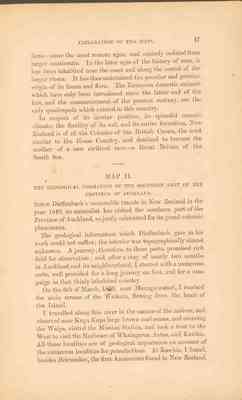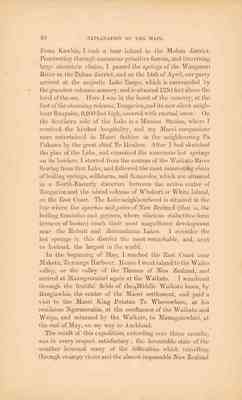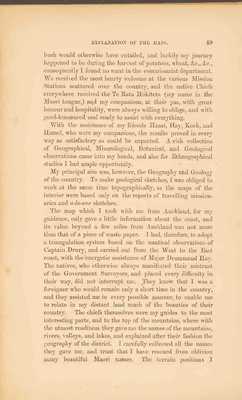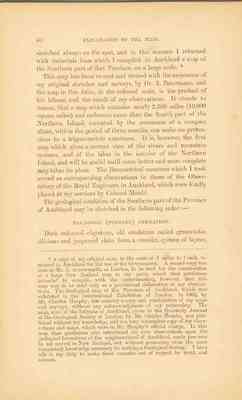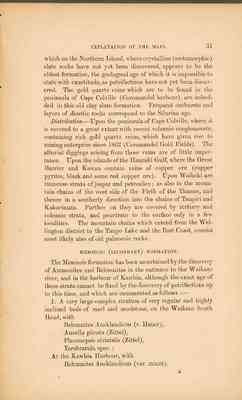Pages
EXPLANATIN OF THE MAPS. 47
form - since the most remote ages, and entirely isolated from larger continents. In the later ages of the history of man, it has been inhabited near the coast and along the course of the larger rivers. It has thus maintained the peculiar and pristine origin of its fauna and flora. The European domestic animals which have only been introduced since the latter end of the last, and the commencement of the present century, are the only quadrupeds which existed in this country.
In respect of its insular position, its splendid oceanic climate, the fertility of its soil, and its entire formation, New Zealand is of all the Colonies of the British Crown, the most similar to the Home Country, and destined to become the mother of a new civilized race - a Great Britain of the South Sea. _____________
MAP II. THE GEOLOGICAL FORMATION OF THE SOUTHERN PART OF THE PROVINCE OF AUCKLAND.
Since Dieffenbach's memorable travels in New Zealand in the year 1840, no naturalist has visited the southern part of the Province of Auckland, so justly celebrated for its grand volcanic phenomena.
The geological information which Dieffenbach gave in his work could not suffice; the interior was topgraphically almost unknown. A journey, therefore, to these parts, promised rich field for observation; and after a stay of nearly two months in Auckland and its neighbourhood, I started with a numerous suite, well provided for a long journey on foot, and for a campaign in that thinly inhabited country.
On the 6th of March, 1859, near Maungatatari, I reached the main stream of the Waikato, flowing from the heart of the Island.
I travelled along this river in the canoes of the natives, and observed near Kupa Kupa large brown coal seams, and entering the Waipa, visited the Mission Station, and took a tour to the West to visit the Harbours of Whaingaroa, Aotea, and Kawhia. All those localities are of geological importance on account of the numerous localities for petrefactions. At Kawhia, I found, besides Belemnites, the first Ammonites found in New Zealand.
48 EXPLANATION OF THE MAPS.
From Kawhia, I took a tour inland to the Mokau district. Penetrating through numerous primitive forests, and traversing large mountain chains, I passed the springs of the Wanganui River in the Tuhua district, and on the 14th of April, our party arrived at the majestic Lake Taupo, which is surrounded by the grandest volcanic scenery, and is situated 1250 feet above the level of the sea. Here I was in the heart of the country, at the foot of the steaming volcano, Tongarro, and its now silent neighbour Ruapahu, 9,200 feet high, covered with eternal snow. On the Southern side of the Lake is a Mission Station, where I received the kindest hospitality, and my Maori companions were entertained in Maori fashion in the neighbouring Pa Pukawa by the great chief Te Heuheu. After I had sketched the plan of the Lake and examined the numerous hot springs on its borders, I started from the sources of the Waikato River flowing from that Lake, and followed the most interesting chain of boiling springs, solfataras, and fumaroles, which are situated in a North-Easterly direction between the active crater of Tongariro and the island volcano of Whakari or White Island, on the East Coast. The Lake neighbourhood is situated in the line where the ngawhas and puias of New Zealand (that is, the boiling fountains and geysers, where silicious stalactites form terraces of basins) reach their most magnificent development near the Rotoiti and Rotomahana Lakes. I consider the hot springs in this district the most remarkable, and, next to Iceland, the largest in the world.
In the beginning of May, I reached the East Coast near Maketu, Tauranga Harbour. Hence I went inland to the Waiho valley, or the valley of the Thames of New Zealand, and arrived at Maungatautari again at the Waikato. I wandered through the fruitful fields of the Middle Waikato basin, by Rangiawhia, the centre of the Maori settlement, and paid a visit to the Maori King Potatau Te Wherowhero, at his residence Ngaruawahia, at the confluence of the Waikato and Waipa, and returned by the Waikato, to Maungatawhiri, at the end of May, on my way to Auckland.
The result of this expedition, extending over three months, was in every respect satisfactory; the favourable state of the weather lessened many of the difficulties which travelling through swampy rivers and the almost impassable New Zealand
EXPLANATION OF THE MAPS. 49
bush would otherwise have entailed, and luckily my journey happened to be during the harvest of potatoes, wheat, &c., &c., consequently I found no want in the commissariat department. We received the most hearty welcome at the various Mission Stations scattered over the country, and the native Chiefs everywhere received the Te Rata Hokiteta (my name in the Maori tongue,) and my companious, at their pas, with great honour and hospitality, were always willing to oblige, and with good-humoured zeal ready to assist with everything.
With the assistance of my friends, Haast, Hay, Koch, and Hamel, who were my companions, the results proved in every way as satisfactory as could be expected. A rich collection of Geographical, Mineralogical, Botanical, and Geological observations came into my hands, and also for Ethnographical studies I had ample opportunity.
My principal aim was, however, the Geography and Geology of the country. To make geological sketches, I was obliged to work at the same time topographically, as the maps of the interior were based only on the reports of travelling missionaries and a-la-vue sketches.
The map which I took with me from Auckland, for my guidance, only gave a little information about the coast, and its value beyond a few miles from Auckland was not more than that of a piece of waste paper. I had, therefore, to adopt a triangulation system based on the nautical observations of Captain Drury, and carried out from the West to the East coast, with the energetic assistance of Major Drummond Hay. The natives, who otherwise always manifested their mistrust of the Government Surveyors, and placed every difficulty in their way, did not interrupt me. They knew that I was a foreigner who would remain only a short time in the country, and they assisted me in every possible manner, to enable me to relate in my distant land much of the beauties of their country. The chiefs themselves were my guides to the most interesting parts, and to the top of the mountains, where with the utmost readiness they gave me the names of the mountains, rivers, valleys, and lakes, and explained after their fashion the geography of the district. I carefully collected all the names they gave me, and trust that I have rescued from oblivion many beautiful Maori names. The terrain positions I
50 EXPLANATION OF THE MAPS.
sketched always on the spot, and in this manner I returned with materials from which I compiled in Auckland a map of the Southern part of that Province, on a large scale. *
This map has been re-cast and revised with the assistance of my original sketches and surveys, by Dr. A. Petermann, and the map in this Atlas, in the reduced scale, is the product of his labour, and the result of my observations. It stands to reason, that a map which contains nearly 2,500 miles (10,000 square miles) and embraces more than the fourth part of the Northern Island, executed by the assistance of a compass alone, within the period of three months, can make no pretensions to a trigonometric exactness. It is, however, the first map which gives a correct view of the rivers and mountain systems, and of the lakes in the interior of the Northern Island, and will be useful until some better and more complete map takes its place. The Barometrical measures which I took served as corresponding observations to those of the Observatory of the Royal Engineers in Auckland, which were kindly placed at my services by Colonel Mould.
The geological condition of the Southern part of the Province of Auckland may be sketched in the following order:-
PALÆOZOIC (PRIMARY) FORMATION.
Dark coloured claystone, old standstone called grauwacke, silicious and jasparoid slate, form a complex system of layers, _________________________________________________________ * A copy of my original map, to the scale of 2 miles to 1 inch, remained in Auckland for the use of the Government. A second copy was sent to Mr. J. Arrowsmith, in London, to be used for the construction of a large New Zealand map in six parts, which that gentleman intended to compile, with the understanding, however, that this map was to be used only as a provisional delineation of my observations. The Geological map of the Province of Auckland, which was exhibited in the International Exhibition of London, in 1862, by Mr Charles Heaphy, was entirely a copy and combination of my maps and surveys, without any acknowledgment of my authorship. The map, also, of the Isthmus of Auckland, given in the Quarterly Journal of the Geological Society of London, by Mr Charles Heaphy, was published without my knowledge, and is a very incomplete copy of my observations and maps, which were in Mr Heaphy's official charge. In this map that gentleman also introduced his own observations upon the geological formations of the neighbourhood of Auckland, made previous to my arrival in New Zealand, but without possessing even the most elementary knowledge necessary for making a Geological survey. I have felt it my duty to make these remarks out of respect for truth and science.
EXPLANATION OF THE MAPS. 51
which on the Northern Island, where crystalline (metamorphic) slate rocks have not yet been discovered, appears to be the oldest formationl the geological age of which it is impossible to state with exactitude, as petrifactions have not yet been discovered. The gold quartz veins which are to be found in the peninsula of Cape Colville (Coromandel harbour), are imbeded in this old clay slate formation. Frequent outbursts and layers of dioritic rocks correspond to the Silurian age.
Distribution. - Upon the peninsula of Cape Colville, where it is covered to a great extent with recent volcanic conglomerate, containing rich gold quartz veins, which have given rise to mining enterprise since 1862 (Coromandel Gold Fields). The alluvial diggings arising from those veins are of little importance. Upon the islands of the Hauraki Gulf, where the Great Barrier and Kawau contain veins of copper ore (copper pyrites, black and some red copper ore). Upon Waiheki are immense strata of jaspar and petrosilex; as also in the mountain chains of the west side of the Firth of the Thames, and thence in a southerly direction into the chains of Taupiri and Kakarimata. Further on they are covered by tertiary and volcanic strata, and penetrate to the surface only in a few localities. The mountain chains which extend from the Wellington district to the Taupo Lake and the East Coast, consist most likely also of old palæozoic rocks.
MESOZOIC (SECONDARY) FORMATION.
The Mesozoic formation has been ascertained by the discovery of Ammonites and Belemnites in the entrance to the Waikato river, and in the harbour of Kawhia, although the exact age of these strata cannot be fixed by the discovery of petrifactions up to this time, and which are enumerated as follows:-
1. A very large complex stratum of very regular and highly inclined beds of marl and sandstone, on the Waikato South Head, with Belemnites Aucklandicus (v. Hauer), Aucella plicata (Zittel), Placunopsis striatula (Zittel), Terebratula spec.; At the Kawhia Harbour, with Belemnites Aucklandicus (var. minor), E
